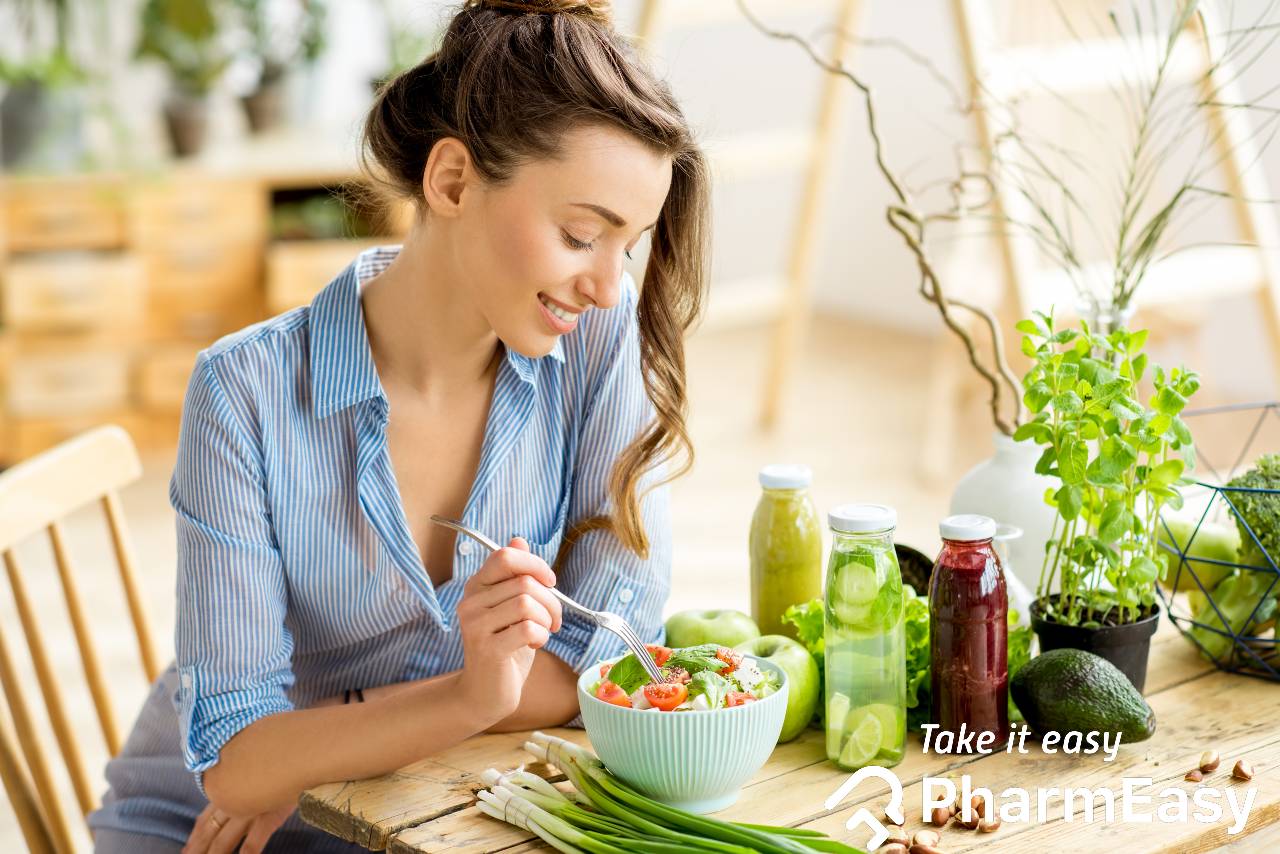4 Healthy Eating Tips For Women
By Dr. Nikita Toshi +2 more

Get,

to manage your symptom
Get your,


4 Cr+ families
benefitted

OTP sent to 9988776655



You’ve successfully subscribed to receive
doctor-approved tips on
Whatsapp

Get ready to feel your best.

Hi There,



Register to Avail the Offer
Send OTPBy continuing, you agree with our Privacy Policy and Terms and Conditions

Hi There,

Trusted by 4 crore+ families

OTP sent to 9988776655



You have unlocked 25% off on medicines




Code: NU25

By Dr. Nikita Toshi +2 more
Women are the pillars of the family. They always balance the demands of family, work, and society. They also have social pressure to eat in a certain way. But, maintaining a healthy diet can be difficult for women. Choosing healthy foods and drinks is the cornerstone of health. It boosts not only your energy but also keeps you healthy during various stages of life.

As women, we often prone to neglecting our health and dietary requirements. It can be because of our busy schedule or used to prioritize our family’s health before our own. This can also be one of the reasons that you are trying to stick to your diet plan so strict that it leaves you short on nutrients and low on energy.
The food choices you make every day may affect your health eventually in life. Choosing healthy food can prevent or manage various health problems that affect women. Also, it is important to note that women have different daily nutritional requirements than men.
Table of Contents
As children, dietary requirements are the same in both genders. But as females reach puberty, the nutritional needs increase because of physical and hormonal changes.
Hormonal changes such as menstruation, pregnancy, and menopause can cause changes in the female body where a healthy diet plays an important role. While women need fewer calories than men, they require a higher amount of vitamins and minerals.
The amount of blood present in your body depends on iron levels. Iron helps to form haemoglobin that carries oxygen in your blood. Iron is essential for everyone, but the amount needed is different for women in every phase of life. Because of loss of blood during menstruation, pregnancy, and delivery; women require the double amount of blood as men. Low levels of iron may cause iron-deficiency anaemia. Here are a few tips to get enough iron from your diet-
Folate or vitamin B9 is essential during childbearing age. It decreases the risk of birth defects when taken before conception and during the first few weeks of pregnancy. Folate can also reduce the risk of getting certain types of cancer and helps to produce estrogen after menopause.
Foods to get folate or vitamin B9 are as follows:
For healthy bones and teeth, we need to eat calcium-rich foods every day. Calcium also helps to regulate the heart’s normal rhythm and normal functioning of the nervous system. If you don’t get enough calcium, your bone will weaken, and this may lead to osteoporosis. Osteoporosis condition is more common in women than in men. Also, calcium deficiency can lead to irritability, weakness, fragile bones, etc. Some tips for more calcium consumption-
Everyone should be taught about the five healthy groups i.e., Grains, proteins, vegetables, fruits and dairy products. Food items with different colors, textures and tastes, both fresh and cooked should be included at every meal and for snacks. The healthiest and the cheapest drink is nothing else but clean water.
Dr. M.G. Kartheeka, MBBS, MD
Also Read: What Are Whole Foods? A Comprehensive Guide to Healthy Eating
For healthy absorption of calcium, you need to take vitamin D and magnesium along with calcium. Without magnesium and vitamin D, the body is unable to metabolise and use calcium. Here are some sources of vitamin D and magnesium –
Women are recommended for and are found to prefer healthier eating habits in the form of wholesome foods, green vegetables, fruits, cereals, etc. which is critical especially iron-rich foods for optimal energy, growth phases that a female goes through and the mood.
Dr. Ashish Bajaj, M.B.B.S., M.D.
Also Read: Ozempic Foods to Avoid: An Integrated Care Approach for Better Health
The dietary requirement is different in every step for women. There are some phases of life where they need to prioritize healthy diet:
1: Daily, healthy eating tips for menstruating women –
2: Healthy eating for pregnant and breastfeeding women
During pregnancy and breastfeeding, a woman needs 300 extra calories than normal women. Because of the increased requirement, you need to focus more on a healthy diet.
3: Diet tips to ease the menopausal symptoms
It is important to understand that women’s nutrition requirement differs from that of men. Include food items in your diet that not only boost your energy levels but also keeps you healthy to perform better at each stage of your life.
Read more about: 12 Health Benefits of Mint Leaves That You Should Know!

Leave your comment...
Comments